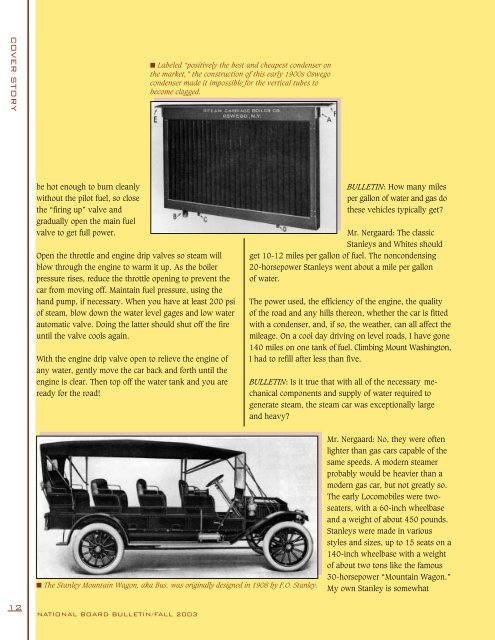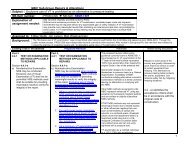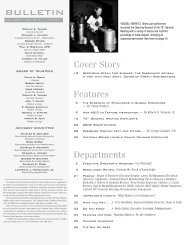bulletin - The National Board of Boiler and Pressure Vessel Inspectors
bulletin - The National Board of Boiler and Pressure Vessel Inspectors
bulletin - The National Board of Boiler and Pressure Vessel Inspectors
You also want an ePaper? Increase the reach of your titles
YUMPU automatically turns print PDFs into web optimized ePapers that Google loves.
COVER STORY<br />
12<br />
be hot enough to burn cleanly<br />
without the pilot fuel, so close<br />
the “firing up” valve <strong>and</strong><br />
gradually open the main fuel<br />
valve to get full power.<br />
Open the throttle <strong>and</strong> engine drip valves so steam will<br />
blow through the engine to warm it up. As the boiler<br />
pressure rises, reduce the throttle opening to prevent the<br />
car from moving <strong>of</strong>f. Maintain fuel pressure, using the<br />
h<strong>and</strong> pump, if necessary. When you have at least 200 psi<br />
<strong>of</strong> steam, blow down the water level gages <strong>and</strong> low water<br />
automatic valve. Doing the latter should shut <strong>of</strong>f the fire<br />
until the valve cools again.<br />
With the engine drip valve open to relieve the engine <strong>of</strong><br />
any water, gently move the car back <strong>and</strong> forth until the<br />
engine is clear. <strong>The</strong>n top <strong>of</strong>f the water tank <strong>and</strong> you are<br />
ready for the road!<br />
NATIONAL BOARD BULLETIN/FALL 2003<br />
■ Labeled “positively the best <strong>and</strong> cheapest condenser on<br />
the market,” the construction <strong>of</strong> this early 1900s Oswego<br />
condenser made it impossible for the vertical tubes to<br />
become clogged.<br />
■ <strong>The</strong> Stanley Mountain Wagon, aka Bus, was originally designed in 1908 by F.O. Stanley.<br />
BULLETIN: How many miles<br />
per gallon <strong>of</strong> water <strong>and</strong> gas do<br />
these vehicles typically get?<br />
Mr. Nergaard: <strong>The</strong> classic<br />
Stanleys <strong>and</strong> Whites should<br />
get 10-12 miles per gallon <strong>of</strong> fuel. <strong>The</strong> noncondensing<br />
20-horsepower Stanleys went about a mile per gallon<br />
<strong>of</strong> water.<br />
<strong>The</strong> power used, the efficiency <strong>of</strong> the engine, the quality<br />
<strong>of</strong> the road <strong>and</strong> any hills thereon, whether the car is fitted<br />
with a condenser, <strong>and</strong>, if so, the weather, can all affect the<br />
mileage. On a cool day driving on level roads, I have gone<br />
140 miles on one tank <strong>of</strong> fuel. Climbing Mount Washington,<br />
I had to refill after less than five.<br />
BULLETIN: Is it true that with all <strong>of</strong> the necessary mechanical<br />
components <strong>and</strong> supply <strong>of</strong> water required to<br />
generate steam, the steam car was exceptionally large<br />
<strong>and</strong> heavy?<br />
Mr. Nergaard: No, they were <strong>of</strong>ten<br />
lighter than gas cars capable <strong>of</strong> the<br />
same speeds. A modern steamer<br />
probably would be heavier than a<br />
modern gas car, but not greatly so.<br />
<strong>The</strong> early Locomobiles were twoseaters,<br />
with a 60-inch wheelbase<br />
<strong>and</strong> a weight <strong>of</strong> about 450 pounds.<br />
Stanleys were made in various<br />
styles <strong>and</strong> sizes, up to 15 seats on a<br />
140-inch wheelbase with a weight<br />
<strong>of</strong> about two tons like the famous<br />
30-horsepower “Mountain Wagon.”<br />
My own Stanley is somewhat








